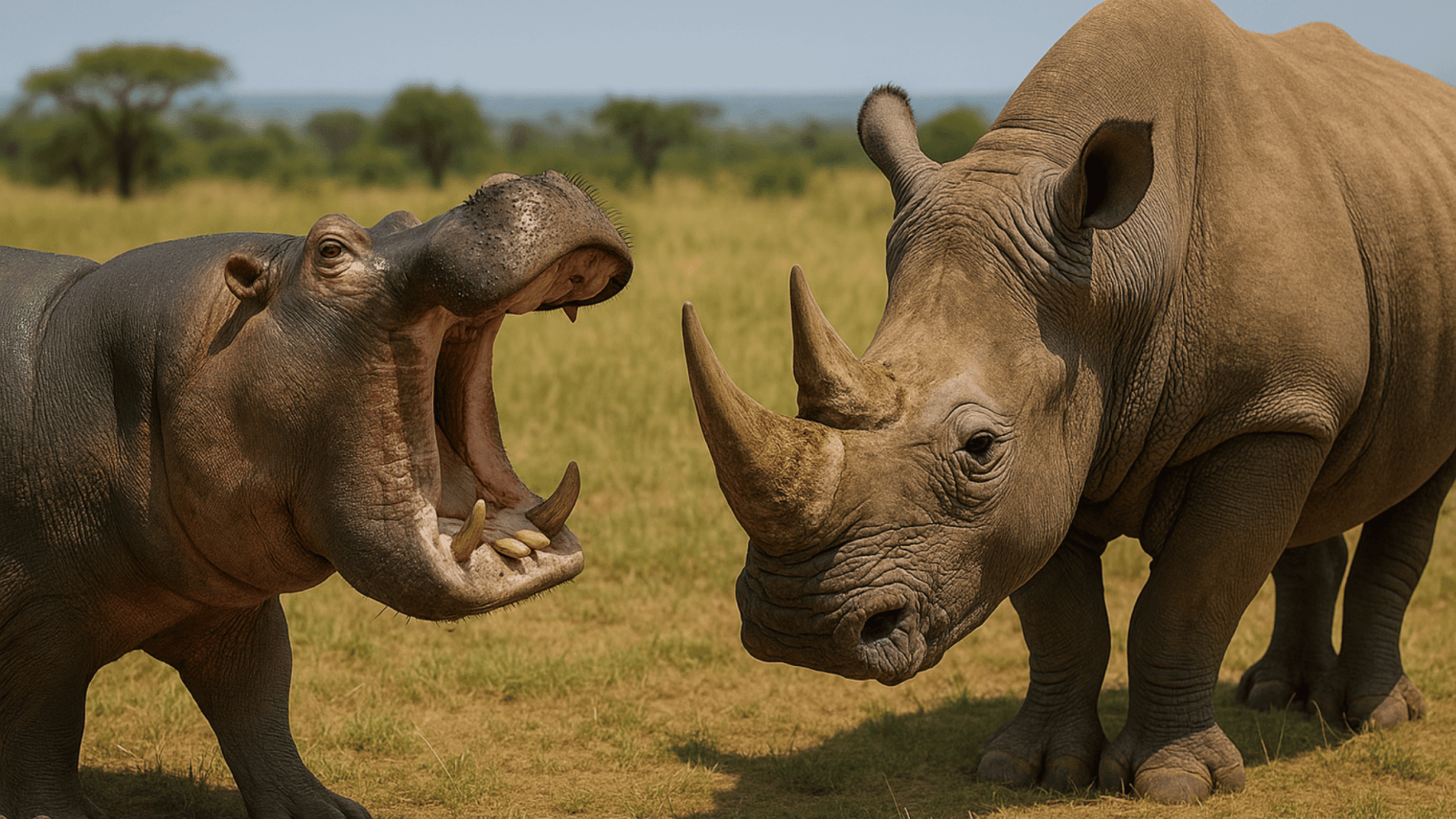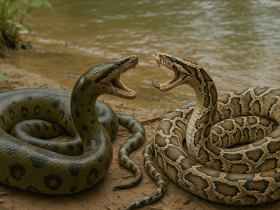In the kingdom of animals there are two war tank like creatures who shares mostly like same features, But still different, Hippo vs Rhino. These two animals are just true representation of raw power and size, Even few land animals are capable of facing hippopotamus and the rhinoceros. Both are heavyweights of the animal kingdom, with territorial temperaments and the physical strength. Even lions and elephants are struggling when facing these tanks.
What if Hippo vs Rhino? Who will win in an Prolonged battle? The hippo is one of the most dangerous animals in Africa, armed with massive jaws and crushing bite force. The rhino, with its armored body and iconic horn, is a living tank built for combat and defense. So its really difficult to imagine the winner in this battle. With this Blog post we will compare them scientifically by talking about their mind blowing features. So keep reading to know the ultimate winner in Hippo vs Rhino fight.
1. Body Specifications
| Subtopic | Hippopotamus | Rhinoceros | Winner |
|---|---|---|---|
| Average Weight (kg) | 1,400–1,800 (♀), up to 2,000 (♂) | 800–1,400 (Black Rhino), up to 2,300 (White Rhino) | Rhinoceros |
| Height at Shoulder (m) | 1.4–1.6 m | 1.6–1.9 m | Rhinoceros |
| Body Length (m) | 3.3–5.0 m | 3.5–4.2 m | Hippopotamus |
| Body Shape | Barrel-shaped, semi-aquatic | Stocky, robust | Draw |
| Bone Density | Very high (for buoyancy) | Very high (land support) | Draw |
| Muscle Mass % | ~44% of body weight | ~40% of body weight | Hippopotamus |
| Skin Thickness | Up to 6 cm | 2.5–5 cm | Hippopotamus |
| Canine/Tusk Size | Up to 50 cm tusks | No tusks; horn up to 150 cm | Hippopotamus (teeth), Rhino (horn) |
| Skull Size | Massive, wide | Long, thick | Draw |
| Tail Length | 35–50 cm | 60–70 cm | Irrelevant |
Category Winner: Draw — Both are massive with different body adaptations for water and land.
2. Skin, Horn, and Teeth – Hippo vs Rhino
| Subtopic | Hippopotamus | Rhinoceros | Winner |
|---|---|---|---|
| Skin Color | Grayish-brown | Grayish to dark brown | Draw |
| Skin Function | Secretes “blood sweat” for UV protection | Armor-like barrier | Hippopotamus |
| Horn Composition | N/A (no horn) | Keratin-based horn | Rhinoceros |
| Tusk Composition | Large canines and incisors | None | Hippopotamus |
| Melanin Levels | Low; uses secretion for sun protection | Moderate | Rhinoceros |
| Skin Healing Rate | Moderate | High | Rhinoceros |
| Biting Surface | Wide gape, tusks designed for slicing | No biting weapon | Hippopotamus |
| Keratin Structures | None | Horn | Rhinoceros |
| Facial Armor | Thick lips and jowls | Armored head | Rhinoceros |
| Horn Regrowth Ability | N/A | Yes | Rhinoceros |
Category Winner: Rhinoceros — Its horn and defensive skin give the win.
3. Habitat and Range
| Subtopic | Hippopotamus | Rhinoceros | Winner |
|---|---|---|---|
| Geographic Range | Sub-Saharan Africa | Sub-Saharan Africa, South Asia (for Indian rhinos) | Draw |
| Habitat Type | Rivers, lakes, wetlands | Grasslands, savannas, forests | Rhinoceros |
| Territory Size (km²) | 1–3 km² | 1–3 km² (Black Rhino), up to 10 km² (White Rhino) | Rhinoceros |
| Altitude Range | Up to 2,000 m | Up to 2,800 m | Rhinoceros |
| Adaptability | Water-dependent | Can survive in dry areas | Rhinoceros |
| Climate Preference | Hot, tropical | Tropical, subtropical, dry | Rhinoceros |
| Migration Patterns | None | Limited, seasonal | Rhinoceros |
| Shelter Use | Water is main refuge | Bushes, trees, terrain | Rhinoceros |
| Human Conflict | High (river conflicts) | High (poaching) | Draw |
| Urban Encroachment Risk | Moderate | High | Hippopotamus (less affected by poaching) |
Category Winner: Rhinoceros — survives in more diverse environments.
4. Diet and Feeding – Hippo vs Rhino
| Subtopic | Hippopotamus | Rhinoceros | Winner |
|---|---|---|---|
| Diet Type | Herbivore (grazing) | Herbivore (browsing & grazing) | Rhinoceros |
| Daily Intake (kg) | 30–40 kg | 50–70 kg | Rhinoceros |
| Foraging Time (hrs/day) | 4–6 hours | 6–12 hours | Rhinoceros |
| Digestive System | Non-ruminant, hindgut | Hindgut fermenter | Rhinoceros |
| Feeding Adaptations | Wide mouth, large lips | Prehensile lip or broad flat mouth | Draw |
| Preferred Plant Type | Short grasses | Grasses, shrubs, trees | Rhinoceros |
| Water Dependency | Extremely high | Moderate | Rhinoceros |
| Aggression During Feeding | Low (at night) | High (territorial males) | Hippopotamus |
| Feeding Location | On land at night | Day and night | Rhinoceros |
| Resource Competition | Low interspecies | High in drought | Hippopotamus |
Category Winner: Rhinoceros — Greater dietary flexibility
5. Strength and Weapons
| Subtopic | Hippopotamus | Rhinoceros | Winner |
|---|---|---|---|
| Bite Force (PSI) | 1,800 PSI | ~200 PSI (not a primary weapon) | Hippopotamus |
| Gape Angle (°) | Up to 150° | ~30–40° | Hippopotamus |
| Canine Size | Up to 50 cm | Absent | Hippopotamus |
| Horn Size | None | Up to 150 cm | Rhinoceros |
| Lifting Power | Medium | High | Rhinoceros |
| Charge Speed | Up to 30 km/h | Up to 50 km/h | Rhinoceros |
| Charge Power | Devastating underwater | Devastating on land | Draw |
| Weapon Durability | Teeth prone to wear | Horns regrow | Rhinoceros |
| Neck Strength | Moderate | High | Rhinoceros |
| Muscle Usage in Combat | Primarily jaw and head | Neck, head, horn | Rhinoceros |
Category Winner: Draw — Both have unique but deadly weapon systems.
6. Speed and Agility
| Subtopic | Hippopotamus | Rhinoceros | Winner |
|---|---|---|---|
| Top Land Speed (km/h) | ~30 km/h | ~50 km/h | Rhinoceros |
| Acceleration | Slow initial burst | Fast initial charge | Rhinoceros |
| Swimming Ability | Excellent (semi-aquatic) | Cannot swim | Hippopotamus |
| Turning Agility | Poor | Moderate | Rhinoceros |
| Balance | Stable in water | Stable on land | Draw |
| Stamina (on land) | Low (quickly overheats) | Moderate | Rhinoceros |
| Underwater Movement | Glides easily | Cannot enter water | Hippopotamus |
| Terrain Adaptability | Only water and flat land | Grassland, forest, rocky areas | Rhinoceros |
| Agility in Combat | Uses head swipe, charges underwater | Agile charge with horn targeting | Rhinoceros |
| Overall Maneuverability | High in water, low on land | Moderate overall | Rhinoceros |
Category Winner: Rhinoceros — Superior speed and land agility
7. Senses – Hippo vs Rhino
| Subtopic | Hippopotamus | Rhinoceros | Winner |
|---|---|---|---|
| Vision (daylight) | Poor | Poor | Draw |
| Night Vision | Moderate (active at night) | Moderate | Draw |
| Hearing | Excellent underwater and on land | Good | Hippopotamus |
| Smell | Excellent (detects territory, mates) | Exceptional (primary sense) | Rhinoceros |
| Sensory Hair | Sparse | Vibrissae on lips | Rhinoceros |
| Environmental Awareness | Strong in water | Strong on land | Draw |
| Communication (sound) | Grunts, bellows, clicks underwater | Snorts, growls, huffs | Draw |
| Tactile Sensitivity | Moderate | Moderate | Draw |
| Echolocation | None | None | N/A |
| Reaction Time | Fast underwater | Fast during charge | Draw |
Category Winner: Draw — Both animals have sharp senses by matching to their environments.
8. Reproduction and Lifespan
| Subtopic | Hippopotamus | Rhinoceros | Winner |
|---|---|---|---|
| Gestation Period (months) | ~8 months | ~15–16 months | Hippopotamus |
| Birth Weight (kg) | 25–50 kg | 40–65 kg | Rhinoceros |
| Litter Size | 1 calf | 1 calf | Draw |
| Interval Between Births | 2 years | 2–4 years | Hippopotamus |
| Age at Sexual Maturity | 5–7 years | 6–7 years | Hippopotamus |
| Parental Care | High maternal protection | High maternal care | Draw |
| Lifespan (Wild) | 40–50 years | 35–50 years | Draw |
| Lifespan (Captivity) | 50+ years | 40–50 years | Hippopotamus |
| Offspring Survival Rate | Moderate | Low to moderate | Hippopotamus |
| Reproductive Rate | Higher due to shorter gestation | Lower due to long gestation | Hippopotamus |
Category Winner: Hippopotamus — Better calf survival
9. Social Behavior – Hippo vs Rhino
| Subtopic | Hippopotamus | Rhinoceros | Winner |
|---|---|---|---|
| Social Structure | Live in pods (up to 30) | Solitary or small mother-calf pairs | Hippopotamus |
| Male Territoriality | Very aggressive in water | Highly territorial on land | Draw |
| Female Bonding | Strong with young | Strong with calf | Draw |
| Group Cooperation | Limited, mostly dominance-based | Not cooperative | Hippopotamus |
| Communication Methods | Grunts, bellows, subsonic calls | Growls, snorts | Hippopotamus |
| Conflict Frequency | High among males | Frequent among males | Draw |
| Defensive Behavior | Circle young, charge intruders | Aggressively defends territory | Draw |
| Aggression Level | Very high (especially males) | Extremely high | Rhinoceros |
| Play Behavior | Seen in young calves | Rare | Hippopotamus |
| Bond Duration | Long maternal bond | Long mother-calf bond | Draw |
Category Winner: Hippopotamus — More social
10. Conservation Status – Hippo vs Rhino
| Subtopic | Hippopotamus | Rhinoceros | Winner |
|---|---|---|---|
| IUCN Status | Vulnerable | Near Threatened (White), Critically Endangered (Black) | Hippopotamus |
| Estimated Wild Population | ~115,000–130,000 | ~18,000 White; ~3,000 Black | Hippopotamus |
| Major Threats | Habitat loss, poaching for ivory | Poaching for horn | Draw |
| Anti-Poaching Success | Moderate | Varies greatly | Draw |
| Captive Breeding Success | High | Moderate | Hippopotamus |
| Habitat Fragmentation | Low (due to water dependence) | High | Hippopotamus |
| Conservation Efforts | Protected in parks | Intensive conservation programs | Rhinoceros |
| Government Protections | Strong in some countries | Strong but patchy | Draw |
| Human Conflict | High (water competition) | Moderate | Rhinoceros |
| Population Trend | Decreasing | Slowly increasing (White Rhino) | Rhinoceros |
Category Winner: Hippopotamus — Rhinos receive more attention
Face-to-Face Fight Analysis: Hippo vs Rhino
In a direct fight between a hippopotamus and a rhinoceros, both animals got the deadly specifications,
-
On land, the rhino has the advantage with its faster speed, powerful charge, and sharp horn. Which can do deadly wounds.
-
In water, the hippo has more advantage— it is agile, buoyant, and capable of using its huge jaws and sharp tusks .
-
The hippo’s bite force (1,800 PSI) is far more higher than the rhino’s jaw strength.
-
However, If rhino attacks successfully with his horn first. Mostly hippo will not stand a chance.
Result: Draw, or location-dependent
-
On land, especially open area: Rhino likely wins.
-
In water or near rivers: Hippo dominates.
Overall scientific Winner – Hippopotamus
Reasons the hippopotamus wins overall:
-
Superior bite force and tusk length.
-
Extremely aggressive and territorial in water.
-
Thicker skin and more muscle mass.
-
Agile and powerful underwater, where it fights best.
-
Greater reproductive rate and calf survival.
Why the rhinoceros loses:
-
Stronger on land, but lacks agility and defenses in water.
-
Less offensive ability at close quarters.
-
weak if ambushed or forced into a riverbank fight.
Interesting Facts
Hippo – Interesting Facts
-
Hippos spend most of their day in water to stay cool.
-
They can hold their breath underwater for up to 5 minutes.
-
Hippos have huge mouths and very big teeth.
-
They are one of the most dangerous animals in Africa.
-
Hippos can run faster than humans on land.
-
They eat mostly grass at night.
-
Their sweat is pink and acts like sunscreen.
-
Baby hippos are born underwater.
-
Hippos make loud noises called grunts and wheezes.
-
They live in groups called pods.
Rhino – Interesting Facts
-
Rhinos have thick, tough skin and one or two horns on their noses.
-
They have poor eyesight but a strong sense of smell.
-
Rhinos love to roll in mud to keep cool and protect their skin.
-
They can weigh over 2,000 kilograms.
-
Rhinos eat grass, leaves, and fruit.
-
Baby rhinos are called calves.
-
Rhinos can run up to 50 km/h for short distances.
-
Some rhinos have only one horn; others have two.
-
They are quiet but can charge if scared.
-
Rhinos are endangered because of poaching.
References:
-
Estes, R. D. (1991). The Behavior Guide to African Mammals. University of California Press.
-
Nowak, R. M. (1999). Walker’s Mammals of the World. Johns Hopkins University Press.
-
IUCN Red List. www.iucnredlist.org
-
Smith, B. H. (2010). Comparative anatomy and functional adaptation of megafauna.
-
Dierenfeld, E. S. (2010). Feeding and nutrition in captive megaherbivores.
-
Owen-Smith, N. (1988). Megaherbivores: The Influence of Very Large Body Size on Ecology. Cambridge University Press.
Read More – Rhino vs Lion : A Comprehensive Comparison






Leave a Reply